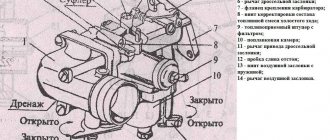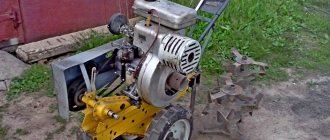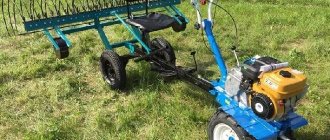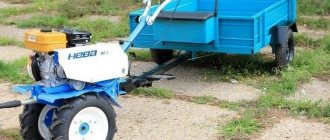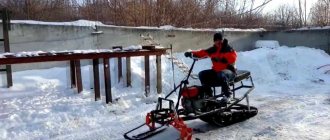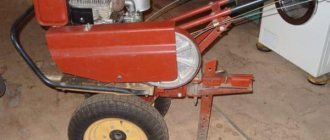How to adjust the carburetor of a walk-behind tractor with your own hands
The walk-behind tractor carburetor must be adjusted periodically to ensure proper operation of the mechanism. A possible cause of differences in the operation of the walk-behind tractor engine may be the carburetor. To do this, the device is disassembled, cleaned and adjusted (adjusted). Regardless of the brand of carburetor and the device on which it is installed, the principle of regulation is the same for everyone. The difference can only be in the number of revolutions.
How to adjust the carburetor of a walk-behind tractor
What should you pay attention to during a motor failure? If a carburetor malfunction occurs, the first thing you need to do is check the fullness of the fuel tank and the oil level. If there is enough fuel and oil, then proceed to inspect the spark plug. To do this, unscrew it and use the ignition to check the spark. Next, the flow of gasoline to the carburetor is tested. For this purpose, remove the hose from the fitting and monitor the flow of fuel. If fuel does not appear, then the filter mesh will most likely need to be cleaned. To do this, the fuel valve is unscrewed and all parts are washed with gasoline. The same is done with the carburetor jet.
Cleaning the carburetor is carried out as follows. To clean the device, you first need to remove it. To easily remove the carburetor, you need to carefully inspect the body of the device and unscrew all the parts on which it is supported.
So, remove the carburetor and pour gasoline out of it. Carefully separate all parts of the device (nozzle, float) for further purging and cleaning. This manipulation is performed with a special cleaner.
In case of heavy contamination, you can use a compressor.
After cleaning, thoroughly dry all the parts and safely proceed to assembly. After assembly, adjust the carburetor for the walk-behind tractor.
We install the cleaned device using the standard gasket and secure it with nuts. Don't forget about the air filter, speed controller and gasoline supply hose.
Setting up the carburetor of a walk-behind tractor involves adjusting it. In order to adjust the carburetor yourself, you need to do the following steps:
- The low and full throttle screws must be tightened until they stop.
- Turn out the low and full throttle screws one and a half turns (we set the throttle valve in such a position that a gap of the appropriate size is formed between the base and the air duct).
- Start the engine and wait until it warms up.
- With the engine running, set the control lever to minimum speed.
- Achieve uninterrupted engine operation. To do this, you need to keep the idle speed to a minimum using the throttle screw.
- Set the idle speed to maximum using the idle screw.
- Set the idle speed to minimum using the throttle screw.
- Repeat steps 6 and 7 until continuous engine operation begins.
- Place the engine control lever on the gas.
- If an interruption occurs, unscrew the screw that regulates the quality of the mixture no more than 2.5 turns.
I would like to note that the carburetor adjustment on the Neva walk-behind tractor is carried out strictly according to the above instructions. The K-45 device installed on the Neva walk-behind tractor is single-chamber and horizontal. The float chamber is located in the central part. The throttle valve is flat.
The Neva walk-behind tractor uses the DM-1K engine, which is produced on. The manufacturer categorically does not use Chinese-made engines. This also applies to the production of motor cultivators.
How to adjust the carburetor
There are several signs that indicate that the carburetor on your walk-behind tractor needs adjustment. Let's list them:
- the engine power of the unit has decreased sharply;
- the volume of fuel consumed has increased rapidly;
- the volume of exhaust gases has increased;
- after starting, the engine turns off spontaneously;
- At idle, the walk-behind tractor engine is unstable.
This is interesting: adjusting the carburetor of a walk-behind tractor.
Each of these problems may have several reasons, including increased loads on the unit or, conversely, long downtime of the walk-behind tractor. An effective measure to eliminate them is to set up the unit. Doing this yourself is not at all difficult. To do this, you need to perform several steps:
- Before tuning, start the engine and warm it up - leave it running for 5 minutes.
- Turn off the device and leave it motionless on a horizontal surface. After this, turn the full and low throttle screws, first until they stop, and then one and a half turns in the opposite direction.
- Start the engine again and warm up for 5 minutes.
- Without turning off, adjust the engine speed control lever to the lowest speed.
- Adjust the throttle screw to the desired position - the one in which engine operation will be the most stable.
- Unscrew the carburetor low speed adjustment screw to the maximum position.
- Set the throttle valve screw to the minimum position.
- Adjust both of the above screws until the engine of the unit begins to demonstrate maximum uninterrupted operation.
- Having adjusted both screws, you need to set the engine speed lever to maximum gas.
- A check is required to complete the setup. To do this, the maximum speed adjustment screw is turned in one direction or the other by two and a half turns in order to check the smooth operation of the motor.
Important! After you have adjusted the mechanism, you should check the unit settings. If it shows uninterrupted operation, and gasoline consumption has decreased, it means that the setting was made correctly.
Carburetor operating instructions
The gasoline that enters this device must not contain mechanical impurities. All parts are processed exclusively with gasoline. The use of solvent is not allowed, as the elasticity of the washer and rubber parts is damaged.
To dry parts, use compressed air. It is not recommended to clean small holes with wire or a needle. Installation after repair or cleaning must be carried out evenly to avoid bending or deformation of parts.
The float chamber must be tightly connected to the body. Before operation, you need to check the connection of the air filter. There should be no gasoline leaks.
Before starting the engine, you should prepare the carburetor. To do this, you need to make sure that gasoline does not leak from it. To do this, just open the fuel tap. Close the air damper and tighten the control lever until it stops. Open the throttle valve to 1/8 - 1/4 of the maximum stroke. At low air temperatures (below +5ºС), squeeze the seal until fuel comes out of the hole.
During startup, open the choke slightly, and after the engine warms up, open it completely.
"Motoblock-master"
Purpose
Carburetors of the K45M3 type are designed for installation on small-displacement single-cylinder and two-cylinder stationary four-stroke engines UD15/UD25 and SK6/SK12.
Technical data
2.1. Technical data of the carburetor are given in the table.
| Options | K45M3 | |
| 1 | Diffuser diameter, mm | 22 |
| 2 | Mixing chamber diameter, mm | 25 |
| 3 | Throughput of the main fuel jet, cm3/min | 200 |
| 4 | Diameter of the air supply hole to the main system, mm | 3 |
| 5 | Dimensions of holes in the main system nozzle: – bottom row – middle row – top row | 4 holes ´0.7 4 holes ´0.7 4 holes ´0.6 |
| 6 | Idle jet diameter, mm | 0,55 |
| 7 | Dimensions of the transition gap - length, mm - width (at the damper), mm - width of the rear wall, mm - distance of the beginning of the gap from the front edge of the throttle valve, mm | 2,6 0,7 0,5 0,2–0,3 |
| 8 | Balancing fitting hole diameter, mm | 3 |
| 9 | Fuel level in the float chamber, mm | 11±1,5 |
| 10 | Weight, kg no more | 0,75 |
Product composition
3.1. Carburetors of the K45M type are single-diffuser with a horizontal mixture flow, with a centrally located float chamber and an L-shaped air pipe, which can be oriented in four directions.
3.2. The K45M type carburetor has a housing 1, which contains: idle system channels 20, main system channels where the atomizer 10 is inserted and air 13 is supplied, altitude corrector channels 33, fuel supply channels to the fuel valve needle. The carburetor has a centrally located float chamber 2 and an air pipe 3 with an air damper 26 built into it.
To start the engine at low temperatures, the carburetor is equipped with a float stop 9.
The throttle valve 25 is butterfly type, the throttle valve axis 31 is vertical, the kinematic link lever 16 with the engine speed controller is attached to the axis.
Design and operation of the carburetor
Fuel enters the carburetor through fuel inlet fitting 4 and is filtered by mesh 34.
A constant fuel level in float chamber 2 is maintained by float 5, connected through lever 8 to the needle of fuel valve 6. The centrally located float chamber allows for a stable fuel level in the main system during rolls and trims.
The idle system is designed with a sequential supply of fuel, after the main jet 11, through the intake tube 19 to the idle fuel jet 18.
The idle system consists of channels 20, an air quality screw for the idle system 22, a fuel jet 18, a slot 21, an emulsion quality idle screw 23, a screw for adjusting the opening of the throttle valve at idle 24.
Screw 22 regulates the operation of the carburetor when the engine is operating in transition modes from idle to load and back. Screw 22 is adjusted and sealed at the service station. Using screws 23 and 24, the consumer regulates engine idle speed.
The main fuel system is made with an emulsifying type atomizer 10, to which fuel enters through the main fuel nozzle 11 and is emulsified by air entering through the air channel 13.
A butterfly-type throttle valve 25 is attached to a horizontal axis 31. A lever 16 is attached to the axis, which is connected by a rod to the engine speed controller.
To manually control the opening of the throttle valve, a leash 17 is attached to the carburetor body, loaded with the friction moment from the lock washers 32.
The carburetor air pipe 3 is L-shaped. The neck of the pipe is oriented towards the filter. The air damper 26 of the starting device is located in the pipe. The air damper axis 30 is driven manually using lever 27. In the closed position, the air damper axis is loaded with a calibrated moment from spring 29. At the initial moment of starting the engine, the air damper overcomes the force of the spring and opens slightly, this facilitates faster engine starting.
In the engine warm-up mode, the air damper is constantly slightly open, which helps to better warm up the engine.
For carburetors, a choke drive lever with a place for connection to a remote control is provided.
The carburetor has a height corrector, consisting of channel 33 and a correction screw 14. In order to reduce fuel consumption through the main system, i.e. for the purpose of correction, screw 14 is smoothly unscrewed, achieving the required degree of “depletion”.
Carburetors use a scheme with balancing of the float chamber 2 through fitting 15 and channel 37 with the engine air filter.
With such a scheme for balancing the float chamber, the carburetor is little critical to clogging of the air filter.
The procedure for installing the carburetor on the engine
5.1. Install and secure the carburetor to the engine flange.
5.2. Attach to the carburetor an air filter, a fuel supply pipe, an interconnection rod connecting the speed regulator to the throttle valve driving lever; install the float chamber balancing tube.
The procedure for preparing the carburetor for starting the engine and warming up
6.1. Completely close the air damper 26, for which: position the air damper control lever 27 along the axis of the carburetor body.
6.2. Set the driver 17 of the manual throttle valve drive to the optimal position for starting (1/4 opening of the full throttle travel).
6.3. Fill the float chamber with fuel (supply fuel manually using the fuel pump), with the plunger 9 pressed, until fuel appears in the transparent balancing tube.
6.4. Start the engine, and from the moment the engine begins to operate steadily, gradually move the air damper to the open position.
6.5. Warm up the engine to the regulated temperature.
Adjusting the carburetor on the engine
7.1. Make sure the engine is warmed up to the specified temperature.
7.2. Check the optimal position of the air quality screw of the idle system 22. Check by turning the screw “left”, “right” by about 1/3 of a turn, achieving maximum stability of the rotation speed when the engine is idling on the regulator.
Carry out an additional check when turning the full load on and off, noting the frequency deviation.
7.3. Adjust the carburetor at idle, to do this, move guide 16 to the idle position. Use the idle speed screw 24 to ensure a minimum stable engine speed, then turn the quality screw 23 to achieve a maximum increase in engine speed. Reduce the engine speed with the screw 24 to the regulated speed.
7.4. Check the operation of the carburetor in all operating modes (if necessary, repeat the adjustments in points 2, 3).
7.5. Place a plug or paint screw 22.
Note: adjustments and work on points 2–5 are carried out in a service center.
Special instructions for use
8.1. The carburetor must be operated with a sealed air filter. Suction of untreated air into the carburetor is not allowed.
8.2. The fuel entering the carburetor must be cleaned of mechanical impurities.
8.3. When installing the carburetor on the engine and when assembling it after cleaning and flushing, the mounting nuts, bolts and screws must be tightened evenly to avoid bending and warping of the flanges. The float chamber must be tightly connected to the body.
8.4. Carburetor parts should only be flushed with fuel. Flushing the carburetor with solvents to avoid dissolving parts from SKU-6 and rubber rings on the screws is not allowed.
8.5. After washing, the carburetor and its parts must be blown with compressed air or dried. It is not allowed to wipe parts with wiping ends.
8.6. Cleaning calibrated holes with metal objects (wire, needles, etc.) is strictly prohibited.
8.7. Check the fuel level with a ruler with plug 35 removed and a fitting with a transparent tube having an internal diameter of at least 6 mm attached. The fuel level is adjusted by bending lever 8.
8.8.
Other requirements according to OST 37.001.207-78. Landline phone: +375(17) 512-37-12. Mobile phones : +375296741674 (A1, Viber and WhatsApp); +375298767878 (MTS).
How to handle the carburetor if the walk-behind tractor has not been used for a long time
In this case, you need to do the following:
- Separate the device from the engine.
- Remove dust using a soft brush and gasoline.
- Unscrew the float and fitting.
- Wash the filter and all parts with clean fuel.
- Blow out using compressed air.
- Check that all parts are dry.
- Assemble the device and install it on the engine.
The carburetor does not require daily major cleaning or adjustment, but it is necessary to monitor its condition for flawless engine operation.
If a walk-behind tractor engine malfunctions, the most common reason is contamination of the device. This is very often due to the quality of gasoline.
The problem may be due to contamination of the carburetor or to the wire connecting the accelerator pedal to the carburetor. If, when the wire is disconnected while the engine is running, the speed indicators return to normal, then the wire will need to be replaced.
Carburetor care for walk-behind tractor
It is possible to prevent a walk-behind tractor from frequent breakdowns or repairs only by carefully monitoring the operation of the mechanism.
As has already become clear, it is important to carry out timely idle adjustment. In addition, do not forget to clean the carburetor, inspect the condition of the parts; to do this, you must first remove them; perhaps they need a complete replacement
For example, gaskets often wear out. Due to constant interaction with fuel liquid and air, the engine becomes heavily polluted. The filters that are installed on the unit will help reduce manual cleaning. In this case, they will have to be cleaned when they become very dirty.
The condition of the equipment is affected by the composition of the fuel being poured. Low-quality flammable liquid impairs the functioning and service of parts and the mechanism as a whole. It is for this reason that craftsmen often resort to replacing or repairing agricultural equipment. You can purchase new spare parts at automobile markets or in stores staffed by qualified specialists.
It is quite easy to adjust the Neva brand device even with your own hands. The main thing is to adhere to the above rules. It will not be superfluous to purchase a connection diagram for each part after repair work or setup, since incorrect installation of spare parts will lead to equipment malfunction - it simply will not start. Try to use high-quality fuel, make adjustments on time, and do not skimp on spare parts. After all, the operation of the entire mechanism depends on every detail.
In the next video you will find cleaning and flushing the carburetor from the Neva MB23 walk-behind tractor.
Let's block ads! (Why?)
Carburetor K-45 for Neva walk-behind tractor
Auto mechanic, specializes in agricultural equipment
Neva walk-behind tractors have long won the recognition of farmers and owners of countryside plots. However, in order for equipment to serve for a long time and work properly, it must be used correctly. Proper engine maintenance is extremely important, but the carburetor is equally important.
Its task is to enrich the fuel with air and transport the combustible mixture to the engine. In order for this part to work smoothly, it requires adjustment from time to time. This allows you to minimize the amount of fuel consumed and increase the productivity of the device - a motor-cultivator or walk-behind tractor. Our article is devoted to how to properly adjust the carburetor of a Neva walk-behind tractor.
Don't forget to adjust the carburetor
Adjusting the KMB-5 carburetor on the Neva walk-behind tractor
The provided diagram will allow you to easily and simply adjust the carburetor of the KMB-5 model to Neva walk-behind tractors on your own.
This instruction is very clear and simple. By carefully following each step, you can easily resume operation of this device. Remember that in order for your unit to serve you faithfully for many years, you must do the following things:
- Carry out continuous diagnostics of the unit.
- Change the oil regularly.
- Adhere to all operating conditions.
These are key actions that will help prolong the performance of all elements and keep your equipment in shape. So follow these simple rules and enjoy the high-quality and efficient operation of your walk-behind tractor.
Carburetor design
The design of the Neva agricultural machinery carburetor is quite simple. Studying it will not be particularly difficult, but at the same time it will allow you to subsequently easily carry out not only adjustments, but also repairs - if such a need arises. This part includes the following components:
- a float connected to a locking needle valve;
- float chamber;
- a chamber in which the fuel is saturated with air;
- diffuser and fuel atomization system;
- throttle valve;
- air and fuel valves.
The task of the float connected to the needle-type valve is to act as a kind of regulator, determining the volume of gasoline in the float chamber. When the amount of fuel decreases, the float moves down and opens the valve, which “admits” a new volume of fuel into the chamber, replenishing it to the required amount. As the chamber fills, the float rises and, when sufficiently filled, closes the valve, preventing excess fuel in the chamber.
In this video you will learn how to disassemble a carburetor:
The function of the atomizer, located between the float and mixing chambers, is to distribute the fuel into the mixing chamber, in which it is saturated with air. Air enters this container through the inlet pipe. It is worth emphasizing here that the gasoline level in the float tank should always be several millimeters below the outlet channel. This is important because when the unit’s engine is turned off, fuel should not splash out of the float chamber, not only when it is on a flat surface, but also when the walk-behind tractor is standing on an incline.
Carburetor gx 390
Before considering how to adjust the carburetor on an Agro walk-behind tractor, you should clarify which option is installed on the walk-behind cultivator, which will allow you to analyze in more detail the process of actions that need to be performed to adjust the device. Let's consider the main points regarding this device, and also version 45 for Agro walk-behind tractors, since they are most often found when arranging a cultivator:
- First of all, it should be noted that the 390, unlike the 45, is produced by Honda.
- In turn, the carburetor for the Agro 45 model walk-behind tractor is made by a domestic manufacturer.
- This device has a corresponding adapter for installation on a motor cultivator of this version.
- The device is equipped with two separate devices for adjusting the position of the damper.
- This well-known model is very popular, but has a relatively low cost (you can purchase the part for 1.5 thousand rubles in the appropriate store or online).
In this video you will learn more about the GX390 carburetor: A tuned carburetor contributes to the correct transfer of a rich mixture to the engine, however, if the element is not tuned, the power plant may not operate correctly, or may not start at all.
Important. It should be understood that this device has calibrated clearances, which is why foreign objects and particles are not allowed in the neck.
Description
This version is nothing special. Here, standard materials and technologies are used in production. The only thing that can be highlighted is the noticeable quality of the Japanese part in comparison with domestic analogues, or similar carburetors from other manufacturers. The device is equipped with a traditional neck, a special valve, and in addition a fuel tap for pumping in an enriched mixture. Additionally, the necessary elements for adjusting the position of the damper are displayed on the design.
Reviews
At the moment, there are comments on the Internet about any technical devices. Regarding this version of the spare part, the following statements are present:
- The original version has an increased resource. This equipment does not go astray after setting, which allows you to forget about the need for adjustment for a long time. Compared to analogues, this device is many times better.
- This version of the device is reliable and durable. All gaps are perfectly calibrated. With the correct settings, you can forget about problems with starting the engine. During the entire period of operation, I highlighted only positive aspects for myself.
Despite the presence of a lot of positive comments, we should not forget that not all of them are true.
Carburetor K45. How does he work?
Dm_Dark, 11+-1.5 MM
Let me revive the topic, in general, there is an ancient agro, serial number 5053, in the winter at -20 it started and drove on 92 gasoline, this spring I changed the oils in the internal combustion engine and gearbox, started it already on 80 gasoline as expected, I drove it for about 5 minutes, after For some time I decided to start it again and go to the field, it drove about 100 meters from me and died, then it never starts until now. I also changed the spark plug for him, it was some kind of ngk all black, I installed what was in the garage A11, and removed the muffler, and removed the carb inside, there were small grains of rust in all the cavities. It was as if someone had gotten there from a tank. I put it back, when I start it with the choke closed, a lot of gasoline splashes from the idle jet and sometimes it fills the spark plug, sometimes there is generally 0 reaction, and sometimes it starts for a couple of seconds but then stalls, if the choke is opened, sometimes it doesn’t react either, sometimes it starts and often with pops and white smoke from under the air filter, there is a spark, gasoline, whether 80 or 92, does not want to work with either. Apart from pieces of rust, all parts of the carburetor are in pretty good condition, I didn’t adjust any screws, because everything worked, although it started and worked only if you initially applied the gas, if at minimum it stalled almost immediately, what could happen to it, it looks like a carburetor or Isn't it about him? By the way, the exhaust was normal white, but the spark plug was all black and now the new one, too, even after those pitiful couple of sneezes that the internal combustion engine makes, it also became black
Does anyone have experience replacing the rubber on the shut-off valve (needle) in the float chamber? In our Zasransk you can’t find your native one, what can you replace it with?
Buy any needle with a ring. There are such things from motorcycles, I don’t know what else there are such things from. And replace one ring. There is no need to change the needle; someone else’s may not fit.
alldn wrote: Buy any needle with a ring. There are such things from motorcycles, I don’t know what else there are such things from. And replace one ring. There is no need to change the needle; someone else’s may not fit.
alldn, Where can I find such a gas-resistant ring? What is it suitable for?
Serje wrote: alldn, Where can I find such a gas-resistant ring? What is it suitable for?
Serje, Ask at an auto parts store.
Shaunsi, this is a K-45R carburetor and it seems to have two more adjustment bolts. Is there a difference in fuel level with pure K-45 due to this?
Good day. There is a K-45 carburetor. Adjustment is needed, and the theme of this carburetor is fully revealed. While studying the forum, I realized only one thing: the carburetor needs to be changed to Japanese, or any other, even Chinese. But! There is a second walk-behind tractor with the same carburetor and it works without problems. So where to start adjusting? Fuel level. According to some sources, 11mm +/- 1.5, according to others 12mm +/- 1.5 from the fuel level to the plane of the hull. There is a second method, found on the promotobloki website - from the top plane of the float to the plane of the body, but unfortunately the gap is not specified. Next is the adjustment process itself: remove the body of the float chamber, place it on the can and connect the fuel by gravity. And here it seems like an ambush occurs - by adjusting the level to 11mm, the float rests on one edge against the lever and wedges it on the tube, and the tendrils of the lever remain free, i.e. the float does not reach them, having already rested against the lever. Tell me, maybe there is another way to adjust and it will be enough to determine the distance from the top plane of the float to the plane of the body? Or measure the level through the fuel pipe? Again, what? There are two more nuances: the xx fuel nozzle has two holes - one transverse and one thin longitudinal from edge to transverse. How should the cross hole be positioned? Closer to air channel xx or emulsion channel xx? Because the channel at the location of this jet changes angle. (Let’s just say, is it necessary to maintain alignment with any of these channels, including in height?) It’s not for nothing that this jet is marked after adjustment. Well, one more question: there are two tubes in the main system. The thin one, which is clamped from above by the above-mentioned jet, and the thicker one, into which the thin one is inserted. So, the thicker one apparently has (I didn’t take it off, but if you look closely you can see it on the side surface) three thin holes. How to remove it, is it necessary, in which direction should these holes be oriented? How to actually clean all this? Because between this tube and the body there is a cavity from which there is a channel into the air chamber.
And another question about adjustment: do we catch maximum speed at the border of a lean mixture or at the border of a rich mixture? Those. tighten the bolt, enrich it, the revs rise, turn it further and hold, then the mixture is quite rich and the revs begin to fall. Where do we catch maximum speed? On the border of a poorer one and twist it by 1/4? Or do we catch one of the boundaries and then catch the minimum ones?
MiDiYi wrote: Fuel level. According to some sources, 11mm +/- 1.5, according to others 12mm +/- 1.5 from the fuel level to the plane of the hull.
My carburetor had worn out the rubber on the needle valve and it began to jam, cutting off the flow of fuel. So, after disassembling the carburetor, I saw that the fuel level was not adjustable at all, i.e. the tongue of the brass plate does not rest anywhere. The carburetor worked fine, the only caveat is that when starting a cold or hot engine, you must close the air damper. The engine starts the first time (maximum the second), even after a winter period of inactivity. The only thing I do for the winter is seal the hole in the gas tank cap. PySy. Along the rubber band on the needle valve. Temporarily solved the problem by flipping the rubber band on the valve.
Repairing the carburetor of the Mole walk-behind tractor
The carburetor of the Mole walk-behind tractor was produced in Soviet times. Despite the fact that the Soviet industry was famous for its high level of performance and reliability, this carburetor still had several flaws. To understand them, you first need to completely analyze it into its components:
- Remove the cover by unscrewing the bolt on it. Underneath we find a gasket made of gas-resistant material, as well as a spring that needs to be pulled out.
- We take out the damper located there, under the cover.
- On the reverse side there is a float chamber, which also needs to be unscrewed. We remove the gasket.
- Then you need to remove the float by removing the pin from the corresponding hole. There is a special needle under the float, which also needs to be removed. On it we find a small elastic band, which under no circumstances should be lost, so we carry out all manipulations very carefully.
- We unscrew the fitting under which the gasoline filter is located.
- Then you need to remove the jet. After this, we need to pull out absolutely all the “internals” located in the carburetor body.
Such disassembly is necessary, because we gain access to the internal contents, which are considered the most problematic.
Disassembly
In other words, we turn this screw, but the mixture does not change, it remains constantly the same.
To change this, you need to make some repairs to the carburetor located inside the Mole walk-behind tractor. The main cause of problems with mixture adjustment is one circumstance. The fact is that inside the carburetor there is a special channel that runs to a tube located in the center of the carburetor.
In this pipe, in theory, there should be a through hole connecting this very channel. The problem is that on some factory units this pipe is installed askew, which leads to the fact that the channel and the hole on the pipe do not match.
There are cases when this hole is completely absent on the pipe, or it is of insufficient diameter. To carry out repairs, we need to perform several sequential steps:
We unscrew both adjusting screws. Please note that the screws have different tapers - the mixture quality screw has a larger taper. To pull out the pipe located inside, we need to slightly heat the part that is located outside
To do this, you can use a small fire on a gas stove, or heat it with a regular lighter. We warm it until we can hold the case in our hands. After that, we insert the pin into the hole where the cover fastening bolt was located. Using a hammer, carefully hit the inserted pin until the pipe pops out. As practice shows, the hole is drilled only on one side of the pipe, i.e. it's not end-to-end
We need to make a symmetrical hole on the other side of this tube, or modify the one that exists. If there is a second hole, but it is smaller in diameter than the first, then we need to sharpen it a little. To do this, we use a regular round needle file and bore the edges of the hole. Then we install the tube in its original place. This must be done in such a way that the through hole on it and the hole on the channel coincide exactly. Before inserting the tube into place, you need to slightly heat the carburetor body again so that it fits into place without problems. We insert the tube into place and, using the same pin that we used to push the pipe out, we insert it into place. We knock lightly so that the pipe does not go far inside - on the back side we should see a hole located just above the through hole, which should coincide with the channel. You need to make sure that the hole is strictly in the center. We take a thick wire and insert it into the channel hole. If everything is done correctly, then the wire should freely pass further through the through hole on the pipe and come out of it as a continuation of the carburetor channel. If the wire gets stuck, then you need to tap the pin a little more, pushing the pipe a little further. Next you need to reassemble the carburetor in reverse order.
That's the whole process of necessary changes in the carburetor design. Thanks to them, the adjusting screw fully fulfills its responsibilities for changing the quality, which, in fact, was required of it.
Carburetors of the Neva walk-behind tractor: features, purpose and operating rules
A carburetor for a walk-behind tractor is a connected part of the power system. The main task is to optimize the fuel to obtain a specific composition. The carburetor first of all needs constant monitoring of loads.
Regular checks, adjustments, and proper operation will help extend the service life of the device. In addition, this is influenced by the configuration of the equipment and the fuel used.
Device Features
The walk-behind tractor is a fairly powerful unit, with great strength, but at the same time of medium size, equipped with multifunctional equipment. The equipment is mainly produced with a gasoline, diesel or electric engine. The latter, by the way, are extremely rare. A carburetor is required for the added fuel to ignite. The manufacturer presents the following types:
- rotary - the simplest in structure, they are mainly equipped with small-sized engines of 12-15 cubic inches;
- plunger - in this case the design is more complicated, therefore it is used for assembling powerful walk-behind tractors.
Carburetion is carried out using the main parts:
- main piston;
- connecting part - fitting;
- fuel tank;
- high/low speed needle;
- Venuri tube.
So, the process begins with a piston moving upward, resulting in the creation of a vacuum. The carburetor absorbs air, and it subsequently moves through the Venuri tube. The movement of fuel (from the tank) is directed towards the engine, this is done using a connecting fitting, which operates due to the created vacuum. The liquid goes around the main needle, flows through the inlet socket, entering the Venuri tube. By pressing the gas lever, fuel is released due to the low speed needle. Next, the first needle is responsible for the flow of gasoline.
Among domestic craftsmen and agricultural workers, equipment of the Russian brands “Neva”, “Oka”, “Agro”, “Utra” is especially popular. It features optimal equipment, a high-quality, powerful carburetor. Russian buyers especially appreciate the Neva K-45 walk-behind tractors for their reliability and durability. The KMB-5 model is an older unit, so before purchasing, consult with a specialist who will provide a product that meets your needs.
For heavy loads, it is recommended to use MB-2 walk-behind tractors - they are equipped with powerful engines and feature reliable carburetors that can operate for many years without forced repairs. MB-1, in turn, is considered a lightweight type that optimizes the functional engine.
Description of the brand "Agro"
is a Ufa enterprise - UMPO, specializing in motor industry. The production of walk-behind tractors in this series began in 1998, and the model itself appeared in the project back in 1996. Since that time, “Agro” walk-behind tractors (or “Agros” - the original name) have gained enormous popularity.
|
More than forty thousand cars rolled off the plant’s assembly line. From 2008 to 2011, Agro production was suspended, and then it was restored and continues to this day.
The popularity of the walk-behind tractor both in the first years of production and today is due to the high quality of spare parts, build quality, and the power of the unit.
The main purpose of the heavy Agro walk-behind tractor is the entire range of work on medium and large areas.
Despite the fact that other Russian manufacturers produce equipment with more horsepower, Agros has not yet given up its leadership position, receiving the most positive reviews from owners.
Adjustment recommendations
Unstable engine operation is the first signal to adjust the carburetor on the walk-behind tractor. Experts advise starting this procedure in early spring - just when you start the mechanism after winter “hibernation”, at the end of autumn - after the end of the load. Disassembly should be carried out in a bright, ventilated area. Setting up the Neva carburetor yourself is not at all difficult, the main thing is to follow the basic recommendations:
- warm up the engine for at least 5 minutes;
- screw the screws in until they stop;
- the screws, in turn, must be adjusted by 1.5 turns;
- set the gear lever to minimum speed;
- in the case of throttle control parts, set only the minimum speed;
- Make sure that the engine is running for the duration of the entire repair - turn it off when completed, then start it again to check/monitor the result;
- The idle speed is regulated by the idle screws - it is important to ensure non-stop operation of the engine;
- If all rules are followed, the carburetor will function quietly and without failures.
Carburetor gx 390
Before considering how to adjust the carburetor on an Agro walk-behind tractor, you should clarify which option is installed on the walk-behind cultivator, which will allow you to analyze in more detail the process of actions that need to be performed to adjust the device. Let's consider the main points regarding this device, and also version 45 for Agro walk-behind tractors, since they are most often found when arranging a cultivator:
- First of all, it should be noted that the 390, unlike the 45, is produced by Honda.
- In turn, the carburetor for the Agro 45 model walk-behind tractor is made by a domestic manufacturer.
- This device has a corresponding adapter for installation on a motor cultivator of this version.
- The device is equipped with two separate devices for adjusting the position of the damper.
- This well-known model is very popular, but has a relatively low cost (you can purchase the part for 1.5 thousand rubles in the appropriate store or online).
In this video you will learn more about the GX390 carburetor: A tuned carburetor contributes to the correct transfer of a rich mixture to the engine, however, if the element is not tuned, the power plant may not operate correctly, or may not start at all.
Important. It should be understood that this device has calibrated clearances, which is why foreign objects and particles are not allowed in the neck.
Description
This version is nothing special. Here, standard materials and technologies are used in production. The only thing that can be highlighted is the noticeable quality of the Japanese part in comparison with domestic analogues, or similar carburetors from other manufacturers. The device is equipped with a traditional neck, a special valve, and in addition a fuel tap for pumping in an enriched mixture. Additionally, the necessary elements for adjusting the position of the damper are displayed on the design.
Reviews
At the moment, there are comments on the Internet about any technical devices. Regarding this version of the spare part, the following statements are present:
- The original version has an increased resource. This equipment does not go astray after setting, which allows you to forget about the need for adjustment for a long time. Compared to analogues, this device is many times better.
- This version of the device is reliable and durable. All gaps are perfectly calibrated. With the correct settings, you can forget about problems with starting the engine. During the entire period of operation, I highlighted only positive aspects for myself.
Despite the presence of a lot of positive comments, we should not forget that not all of them are true.
Operating rules
The device will last a long time if you follow the following recommendations.
- To keep the mechanism in working condition, it is important to monitor the composition of the supplied gasoline - it should not contain mechanical impurities.
- Before starting repair work, it is necessary to treat the parts with the same fuel. It is not recommended to use solvent, as it can reduce the elasticity of rubber parts and damage washers.
- It is best to dry parts by blowing with compressed air.
- Do not clean small holes, for example, with a needle or wire.
- Perform final assembly and installation of parts evenly - this way you can avoid deformation or bending of carburetor parts.
- Make sure that the float chamber is tightly connected to the body - future success lies precisely in their tightness.
- Before starting the mechanism, check how the air filter is connected - you should be wary of fluid leaks.
- To avoid leakage, the fuel valve must be opened, then the air damper must be closed, the control lever must be tightened tightly, and the throttle valve must be opened to 18-14. The seal should be pressed until drops of fuel appear (if the temperature has dropped to 5 degrees).
- When starting, the air damper must be opened slightly. As soon as the engine warms up, open it all the way.
